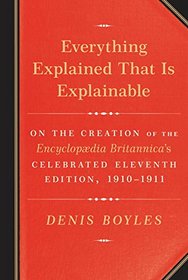Search -
Everything Explained That Is Explainable: On the Creation of the Encyclopaedia Britannica's Celebrated Eleventh Edition, 1910-1911
Everything Explained That Is Explainable On the Creation of the Encyclopaedia Britannica's Celebrated Eleventh Edition 19101911
Author:
The audacious, improbable tale of how twentieth-century American hucksterism, outlandish daring, and vision resurrected a dying Encyclopędia Britannica and a floundering London Times. The Britannica's astonishing success changed newspaper and reference-book publishing and resulted in the Britannica's beloved eleventh edition, the most celebrated... more »
Author:
The audacious, improbable tale of how twentieth-century American hucksterism, outlandish daring, and vision resurrected a dying Encyclopędia Britannica and a floundering London Times. The Britannica's astonishing success changed newspaper and reference-book publishing and resulted in the Britannica's beloved eleventh edition, the most celebrated... more »
ISBN-13: 9780307269171
ISBN-10: 0307269175
Publication Date: 6/7/2016
Pages: 464
Rating: ?
ISBN-10: 0307269175
Publication Date: 6/7/2016
Pages: 464
Rating: ?
0 stars, based on 0 rating
Genres:
- History >> Historical Study & Educational Resources >> Study & Teaching
- History >> World
- Reference >> Encyclopedias & Subject Guides >> History
- Reference >> Publishing & Books




